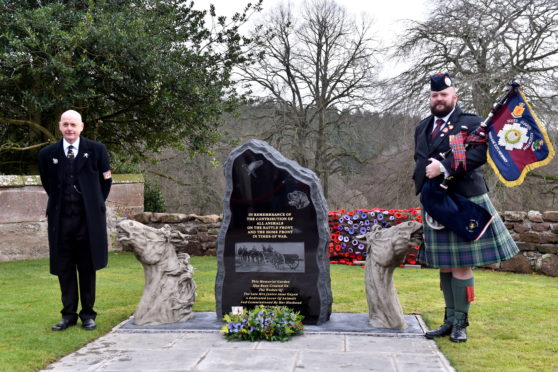A north-east man has fulfilled his wife’s dying wish by unveiling a memorial honouring animals who were killed at war.
Aberdeen man Graham Guyan spearheaded the creation of a modest garden featuring a headstone and sculptures, which was opened in front of Delgatie Castle near Turriff on Saturday.
Mr Guyan’s wife, Jan, was a devoted animal enthusiast and she asked that the site be created as a “legacy” to her upon her death.
>> Keep up to date with the latest news with The P&J newsletter
It now offers a peaceful spot for reflection for anyone who wishes to use it.
A dark granite stone, flanked by two carvings of horses neighing, reads: “In remembrance of the contribution of all animals on the battle front and the home front in times of war.”
Mrs Guyan, who died from cancer two-and-a-half years ago aged 66, made it her last wish to create the space – and insisted it be in the north-east.
Mr Guyan described the poignant ceremony as “very sad, but fantastic”.
He said: “This garden is for all animals killed during wars, many of whom were used in the battlefields.
“My wife and I had a lot of animals, and she began to believe there should be a memorial for those who died in conflict after reading up on their history during times of war.
“I think this may even be one of the first permanent memorial of its kind in Scotland, or at least in this area.
“She told me ‘when I go, try and put up a memorial’ so that’s what I did.
“Seeing it all come together at the unveiling was fantastic, very sad but fantastic.
“It’s a great tribute to animals of war, and to my wife as well.”
As he worked to set up the garden, Mr Guyan received assistance from Joan Johnson, a trustee attached to the 11th century castle.
The grieving husband believed it was ideal for the location to be near Banff as many horses used in the First World War were from the town.
The unveiling was attended by a piper, the British Legion, Turriff cadets, numerous animal charities and a few dogs and horses.
Mr Guyan added: “It’s a great thing to remember the many sacrifices of those people that fought in the war.
“But we also have to make sure the animals aren’t forgotten, as such, a lot of people don’t realise the number of animals that went to war.
“It’s great to give them recognition.”
It is estimated that 16 million animals served in the First World War.
That number includes eight million horses and countless mules and donkeys, and more than 200,000 carrier pigeons met their demise while conveying important messages.
Domestic animals have also been utilised in wars over the decades, with cats trained to hunt rats and dogs taught to carry and locate explosives.
The UK’s most notable shrine to animals who have died in conflict is the Animals in War Memorial, which was unveiled by Princess Anne in Hyde Park in London in 2004.
